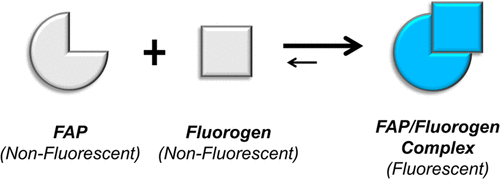当前位置:
X-MOL 学术
›
Bioconjugate Chem.
›
论文详情
Our official English website, www.x-mol.net, welcomes your feedback! (Note: you will need to create a separate account there.)
Fluorogen-Activating Proteins: Next-Generation Fluorescence Probes for Biological Research.
Bioconjugate Chemistry ( IF 4.7 ) Pub Date : 2019-12-13 , DOI: 10.1021/acs.bioconjchem.9b00710 Eugenio Gallo 1
Bioconjugate Chemistry ( IF 4.7 ) Pub Date : 2019-12-13 , DOI: 10.1021/acs.bioconjchem.9b00710 Eugenio Gallo 1
Affiliation

|
Since their discovery, fluorescent probes have found widespread use in biological research. Over time, multiple next-generation probes increased the fluorescence catalog by offering novel capabilities of detection that have been previously difficult or lacking with conventional probes. One of such probes is called a fluorogen-activating protein (FAP). These are bimodular sensors, composed of a single-chain antibody that exhibits high-affinity and selectivity for small-molecule fluorogens. Because fluorogens are inherently nonfluorescent unless sterically restricted, upon the formation of the noncovalent FAP-fluorogen complex the fluorogen module emits fluorescence when excited by light. More interestingly, these bimodular sensors permit improvement of their biophysical properties. For instance, the fluorescence spectra and environmental sensing capabilities of fluorogens may be altered by the method of chemical modification at the fluorogen structural level. Also, optimizations of the single-chain antibody scaffold, via amino acid substitutions at the selectivity regions, may improve the detection brightness and affinities of fluorogens; this may also improve the biophysical stability of FAPs in different cellular environments. Additionally, when utilized as biological discovery probes, FAP biosensors exhibit functional activity as genetic fusion tags with cellular proteins; this results in high fluorescent sensitivities of cell surface and intracellular targets. Also, FAPs allow the monitoring of cellular traffic of surface receptors by fluorescence methods of real-time color switching, or signal onset and offset. They find application as biological probes integrated into biomaterials, or as soluble affinity reagents for whole live animal studies. Overall, this noncovalent activation of fluorogen particles results in advanced strategies of fluorescence detection.
中文翻译:

氟激活蛋白:用于生物学研究的下一代荧光探针。
自发现以来,荧光探针已在生物学研究中广泛使用。随着时间的流逝,多个下一代探针通过提供以前难以使用或无法使用常规探针提供的新颖检测功能,增加了荧光种类。这种探针之一被称为荧光激活蛋白(FAP)。这些是双模块传感器,由单链抗体组成,对小分子氟具有高亲和力和选择性。因为除非空间限制,否则氟固有地是非荧光的,因此在形成非共价的FAP-氟络合物时,氟模块在被光激发时会发出荧光。更有趣的是,这些双模块传感器可以改善其生物物理特性。例如,氟的荧光光谱和环境感应能力可以通过在氟结构水平上进行化学修饰的方法来改变。同样,通过在选择性区域进行氨基酸取代来优化单链抗体支架,可以提高检测亮度和氟的亲和力。这也可以改善FAP在不同细胞环境中的生物物理稳定性。另外,当用作生物发现探针时,FAP生物传感器具有与细胞蛋白的遗传融合标签的功能。这导致细胞表面和细胞内靶标的高荧光敏感性。而且,FAP允许通过实时颜色切换或信号发生和偏移的荧光方法来监视表面受体的细胞运输。他们发现它们可作为集成到生物材料中的生物探针或可用于整个活体动物研究的可溶性亲和试剂。总的来说,这种非共价的氟粒子活化作用导致了先进的荧光检测策略。
更新日期:2019-12-13
中文翻译:

氟激活蛋白:用于生物学研究的下一代荧光探针。
自发现以来,荧光探针已在生物学研究中广泛使用。随着时间的流逝,多个下一代探针通过提供以前难以使用或无法使用常规探针提供的新颖检测功能,增加了荧光种类。这种探针之一被称为荧光激活蛋白(FAP)。这些是双模块传感器,由单链抗体组成,对小分子氟具有高亲和力和选择性。因为除非空间限制,否则氟固有地是非荧光的,因此在形成非共价的FAP-氟络合物时,氟模块在被光激发时会发出荧光。更有趣的是,这些双模块传感器可以改善其生物物理特性。例如,氟的荧光光谱和环境感应能力可以通过在氟结构水平上进行化学修饰的方法来改变。同样,通过在选择性区域进行氨基酸取代来优化单链抗体支架,可以提高检测亮度和氟的亲和力。这也可以改善FAP在不同细胞环境中的生物物理稳定性。另外,当用作生物发现探针时,FAP生物传感器具有与细胞蛋白的遗传融合标签的功能。这导致细胞表面和细胞内靶标的高荧光敏感性。而且,FAP允许通过实时颜色切换或信号发生和偏移的荧光方法来监视表面受体的细胞运输。他们发现它们可作为集成到生物材料中的生物探针或可用于整个活体动物研究的可溶性亲和试剂。总的来说,这种非共价的氟粒子活化作用导致了先进的荧光检测策略。


























 京公网安备 11010802027423号
京公网安备 11010802027423号